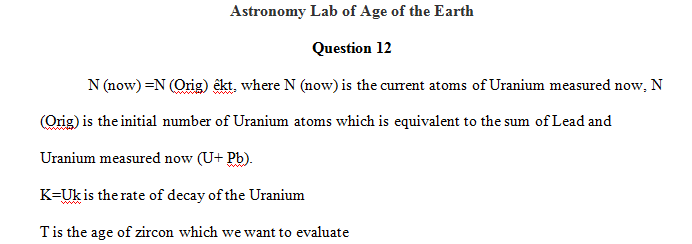In order to date the Earth, we need isotopes with much longer half-lives.
Astronomy lab of age of the earth
4. The Age of the Earth
In order to date the Earth, we need isotopes with much longer half-lives. Two of these are uranium-235 (which decays into lead-207) and potassium-40 (which decays into argon-40). The age of the Earth has been measured with these radioactive decays, as well as others. First, let’s think about the decay of uranium-235 into lead-207 with a half-life of 710 million years. A type of rock called zircon sometimes forms with uranium atoms included in it, but does not include lead.
Question 12: Geologists have found zircon crystals all around the world like this. Suppose that you find such a crystal, and there are fifteen lead-207 atoms for every uranium-235 atom inside the zircon. How long ago did this rock form? If you are stuck on this problem, retrace the history of the uranium-235 and lead-207 in this crystal in the following table. I’ve filled out the first two rows for you:
Half-lives Years elapsed 235U fraction 207Pb fraction Schematic of atoms
0 0 16/16 0/16 UUUUUUUUUUUUUUUU
1 710 million 8/16 8/16 LLLLLLLLUUUUUUUU
2
3
Question 13: The oldest zircon crystals that we find have around sixty-three lead-207 atoms for every uranium-235 atom; in other words, the composition of these two atoms, taken together, is 63/64 lead-207 and 1/64 uranium-235. About how old are they? This gives us an estimate of the age when the Earth’s surface cooled enough to form rocks like zircon. (It is actually a few hundred million years older than this; I rounded off to a 63:1 ratio to make it easier to do the math.)
Question 14: When we apply radioactive dating to asteroids that fall to Earth, rocks from the Moon, and the surface of Mars (using robots), we get the same value: around 4.5 billion years old. Is this consistent with the model of solar system formation we discussed in class? Explain.
5. A Natural Nuclear Reactor?
As we discussed earlier, uranium is made of two isotopes: 235U and 238U. 238U cannot be used to sustain a nuclear chain reaction, but 235U can. These isotopes are always found mixed together in nature.
To produce a nuclear chain reaction (as in a power plant), uranium must be mixed with another substance called a moderator.
If a mixture contains more than 2% or so of 235U mixed with water, it will “go critical”, like a nuclear power plant, and produce lots of heat. However, natural uranium is only 0.5% 235U and 99.5% 238U, so we cannot build a nuclear reactor out of natural uranium and water.
In the previous part, you discovered that 63/64 of the 235U that was present when the Earth was formed has decayed. However, the half-life of 238U is much longer; it is about 6 times longer (4.5 billion years rather than 710 million years).
Fire up the Google dice roller again, and add lots of 20-sided dice (d20’s) and lots of 4-sided dice (d4’s). Roll them many times, removing all of them that come up “1”. As you may have guessed, the d20’s represent one isotope of uranium, and the d4’s represent the other.
Which type of die represents atoms of the long-lived isotope (238U) and which represents the short-lived one (235U)?
Over time, how does the fraction of 235U in the remaining pool of uranium atoms change?
Question 15: Around two billion years ago, geologists believe that a “natural nuclear reactor” formed in what is now Oklo, Gabon, in Central Africa. At that time (about three half-lives of 235U ago), was the 235U percentage of Earth’s uranium higher, lower, or the same as it is now? Estimate that percentage. (Remember, both isotopes of uranium are radioactive, but 238U has a much longer half-life. You don’t have the tools to calculate exactly how much the 238U has decayed in two billion years; you should estimate this given that two billion years is about one-half of its half-life.)
Answer preview in order to date the Earth, we need isotopes with much longer half-lives.
APA
1242 words

